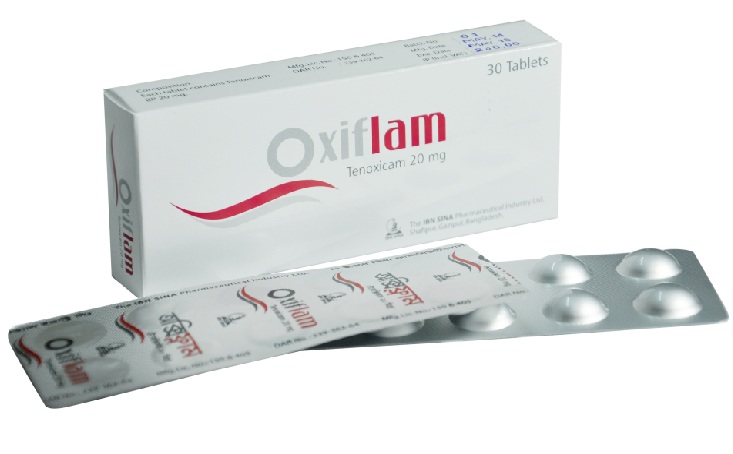
OXIFLAM
TENOXICAM
| NAME | STRENGTH | PACK SIZE | DOSAGE FORM |
|---|---|---|---|
| OXIFLAM 20 MG | 20 MG | 30 S | TABLET |
Each film coated tablet contains Tenoxicam BP 20 mg.
The anti-inflammatory effects of Tenoxicam may result from the inhibition of the enzyme cyclo-oxygenase and the subsequent peripheral inhibition of prostaglandin synthesis. As prostaglandins sensitize pain receptors, their inhibition accounts for the peripheral analgesic effects of Tenoxicam. Antipyresis may occur by central action on the hypothalamus, resulting in peripheral dilation, increased cutaneous blood flow, and subsequent heat loss.
Oxiflam is indicated for the symptomatic treatment of the following painful, inflammatory and degenerative disorders of the musculoskeletal system: • Rheumatoid arthritis
• Osteoarthritis
• Ankylosing spondylitis
• Extra-articular disorders, e.g. tendinitis, bursitis, periarthritis of shoulders (shoulder-hand syndrome) or hips, strains and sprains
• Post-operative pain
• Acute gout
• Primary dysmenorrhoea
For all indications except primary dysmenorrhoea, postoperative pain and acute gout,a daily dosage of 20 mg should be given at the same time of day. The recommended dose for primary dysmenorrhoea is 20 to 40 mg once daily. For post-operative pain the recommended dose is 40 mg once daily up to five days and for acute attacks of gout the recommended dose is 40 mg once daily for two days followed by 20 mg once daily for a further five days. For patients needing long-term treatment a reduction to a daily oral dose of 10 mg may be tried for maintenance. The tablet should be taken with a glass of water. It is preferable to lake this medicine during or immediately after a meal. Children: No dosage recommendations have so far been established.
Tenoxicam is contraindicated in patients with known hypersensitivity to Tenoxicam or any component of the product or other non-steroidal anti-inflammatory drugs (NSAIDs); in whom salicylates or other non-steroidal antiinflammatory drugs (NSAIDs) induce symptoms of asthma, rhinitis or urticaria; suffering or having suffered from disease of the upper gastrointestinal tract, such as gastritis, gastric and duodenal ulcer.
NSAIDS inhibit renal prostaglandin synthesis and consequently may have an undesirable effect on renal
hemodynamics and on salt and water balance. It is necessary to adequately monitor the patient with a special emphasis on cardiac and renal function (BUN, creatinine, development of edema, weight gain, etc.) when giving Tenoxicam to patients with conditions that could increase their risk of developing renal failure, such as pre-existingrenal disease, impaired renal function in diabetics, hepatic cirrhosis, congestive heart failure, volume depletion or concomitant treatment with potentially nephrotoxic drugs, diuretics and corticosteroids. Tenoxicam inhibits platelet aggregation and may affect hemostasis. Tenoxicam has no significant influence on blood coagulation factors, coagulation time, prothrombin time or activated thromboplastin time. Patients having coagulation disorders or receiving drug therapy that interferes with hemostasis should, however, be carefully observed when Tenoxicam is administered. Any patient being treated with Tenoxicam who presents with symptoms of gastrointestinal disease
should be closely monitored. If peptic ulceration or gastrointestinal bleeding occurs, Tenoxicam should be immediately withdrawn. If severe skin reactions (e.g. Lyell's or Stevens-Johnson syndrome) occur, the treatment should be discontinued immediately. Adverse eye findings have been reported with Tenoxicam. Thus ophthalmic evaluation is recommended for patients who develop visual disturbances. Because of the high plasma protein binding of tenoxicam, caution is required when plasma albumin levels are markedly reduced. In common with anti-inflammatory drugs, Tenoxicam may mask the usual signs of infection. Tenoxicam Tablets should not be given to patients who either dislike or do not tolerate milk products.
Tenoxicam proved to be well tolerated in the recommended dose. Usually the undesirable effects reported were mild and transient. The following undesirable effects have been reported: Frequency greater than 1%: Gastrointestinal tract: gastric, epigastric and abdominal discomfort, dyspepsia, heartburn, nausea. Central nervous system: dizziness, headache.Frequency less than 1%: Gastrointestinal tract: constipation, diarrhea, stomatitis, gastritis, vomiting, ulcers, GI-bleeding. Central nervous system: fatigue, sleep disturbances, appetite loss, dry mouth, vertigo. Skin: itching, erythema, exanthema, rash, urticaria. Urinary tract and kidneys: increase in BUN or creatinine, edema. Liver and biliary tract: increased liver enzyme activity. Cardiovascular system: palpitations.
NSAIDs have an inhibitory effect on prostaglandin synthesis and, when given during late pregnancy, may cause closure of the fetal ductus arteriosus, prolong labor and delay parturition. Treatment during the third trimester of pregnancy should be avoided. There is no evidence of adverse reactions in breast-fed infants of mothers taking Tenoxicam. Nevertheless, infants should be weaned or the drug discontinued.
Tenoxicam may have the following drug interactions: Acetylsalicylate and Salicylates: Salicylates increase the clearance and volume of distribution of NSAIDs including Tenoxicam. Anti-platelet agents and SSRls: There is an increased risk of gastrointestinal bleeding when anti-platelet agents and selective serotonin-reuptake inhibitors (SSRls) are combined with NSAIDs Methotrexate : Caution should be exercised if NSAIDs and Methotrexate are administered within 24 hours of each other, since NSAIDs may increase Methotrexate plasma levels, resulting in increased toxicity. Diuretics and antihypertensives: No clinically significant interaction between Tenoxicam and Frusemide was noted, but Tenoxicam attenuates the blood pressure lowering effect of Hydrochlorothiazide. As known from other NSAIDs, Tenoxicam might attenuate the antihypertensive effects of alpha-adrenergic blockers and ACE-inhibitors.
Symptoms associated with ingested overdose of benzydamine are mainly gastrointestinal symptoms and symptoms of the central nervous system. Most frequent gastrointestinal symptoms are nausea, vomiting, abdominal pain and oesophageal irritation. Symptoms of the central nervous system include dizziness, hallucinations, agitation, anxiety and irritability.
Store in a cool (below 30° C) & dry place, protected from light. Keep out of reach of children.
Oxifam tablet: Each box contains 30's tablets in alu-alu blister pack.
